The time period between 1895 and 1896 was probably one
of the most busy and productive for Albert D. He developed at least
six different tools and received patents for all of them. There were most likely
other tools and manufacturing
solutions developed during this time, which were not patented.
By the end of 1896, Albert D. registered two more patents. Both of them were for chucks.
The first
patent with
No. 563,372 was issued on July 7, 1896 and it was
designed specifically for bit braces. The second patent
arrived on September 1, 1896 and received
No. 566,905. This chuck was designed for drills.
It appears that the flow of new designs stopped
for a while at the end of 1896. Apparently, sometime in
the early 1889s, Albert D. was struck by arthritis and heart
disease. This illness
limited him to a great extent and shadowed him for the rest of his
life. (48)
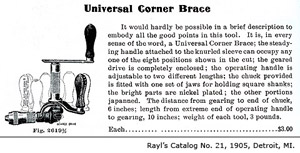 Still, in
1904 Albert D. went back to the drawing board and designed a
Corner Brace. The patent was issued on May 9, 1905 under
No.
789,536.
The brace was manufactured and sold by Goodell Tool Co. and by
various hardware houses. In the catalog No. 21 by Rayl's,
a Detroit, MI, hardware dealer, the brace was offered as one of
three choices and was priced the highest.
Goodell-Pratt Co. also listed this brace in the Catalog No.
10, 1911.
Still, in
1904 Albert D. went back to the drawing board and designed a
Corner Brace. The patent was issued on May 9, 1905 under
No.
789,536.
The brace was manufactured and sold by Goodell Tool Co. and by
various hardware houses. In the catalog No. 21 by Rayl's,
a Detroit, MI, hardware dealer, the brace was offered as one of
three choices and was priced the highest.
Goodell-Pratt Co. also listed this brace in the Catalog No.
10, 1911.
After pausing for a few years, Albert D.
put his creativity to work again in 1910. He filed an application for
a Bench Stop in July, 1910
and the patent was issued on November 1, 1910 with
No. 974,482.
The patent was assigned to Goodell Tool Co. Although
similar types of bench stops were already known and available on
the market for several years, Albert D. included some unique
features in his design.
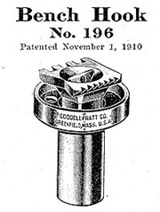 "The
improvements especially pertain to constructions in the
bench stop which enable the user to obtain an engagement
between the shank of the stop piece and an internal portion
of the bushing piece for supporting the stop very little, or
considerably above the top surface of the bench, and to also
insure, when the stop is not required for use that it will
have a lowered position to leave the top of the bench flush
and clear."
"The
improvements especially pertain to constructions in the
bench stop which enable the user to obtain an engagement
between the shank of the stop piece and an internal portion
of the bushing piece for supporting the stop very little, or
considerably above the top surface of the bench, and to also
insure, when the stop is not required for use that it will
have a lowered position to leave the top of the bench flush
and clear."
The Bench Stop was advertised and sold
directly by Goodell Tool Co. but it also appeared in the
Goodell-Pratt Co. catalog No. 10, in 1911. As a matter of fact, several tools designed and marketed by
Albert D. appeared in the Goodell-Pratt Catalog No. 10, 1911.
Among them were several variations of Glass Cutters, a Universal
Corner Brace, and now a Bench Stop. Goodell-Pratt Co.
named it a Bench Hook No. 196.
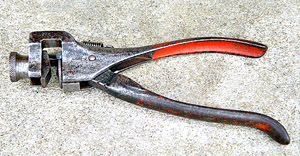 The next year Albert D. designed two
more
tools - a Saw Set and the Device for Turning Shoulders on Wooden Spokes.
The Saw Set was patented on February 14, 1911 and received
No. 984,478.
It
was manufactured and sold by Goodell Tool Co. and
later by Goodell-Pratt Company.
The next year Albert D. designed two
more
tools - a Saw Set and the Device for Turning Shoulders on Wooden Spokes.
The Saw Set was patented on February 14, 1911 and received
No. 984,478.
It
was manufactured and sold by Goodell Tool Co. and
later by Goodell-Pratt Company.
The next patent received by Albert D. Goodell was for
the "Device for Turning Shoulders on
Wooden Spokes". It arrived on December 5, 1911 with
No. 1,010,894. The history of this tool is
somewhat convoluted and I did not find answers to all the
questions I had.
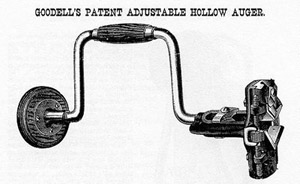 In the Millers Falls Co.'s catalog
from 1887, the tool shown here is named "Goodell's Patent
Adjustable Hollow Auger". Despite my best efforts, I didn't
find a patent for this tool. Instead, Albert D Goodell
received a patent for a similar tool in 1911, as mentioned above.
In the Millers Falls Co.'s catalog
from 1887, the tool shown here is named "Goodell's Patent
Adjustable Hollow Auger". Despite my best efforts, I didn't
find a patent for this tool. Instead, Albert D Goodell
received a patent for a similar tool in 1911, as mentioned above.
Was the catalog listing another shenanigan, perpetrated by
Millers Falls Co.? The same listing appeared in the
Millers Falls Co. 1894
catalog, but in the 1903 edition the name
of the tool was changed to "Patent Adjustable Hollow Auger No. 1." Was this a repetition of the story with the
Goodell's Ratchet Drills we
described at the beginning of this article? It would be only a speculation,
although supported by these two facts, but I do have a nagging
feeling that William W. Pratt had a very serious conversation
with Levi J. Gunn of Millers Falls Co. and convinced him to drop
Goodell's name from the catalogs. I will leave it to the readers to share
their discoveries with me.
The
patent Albert D. received on December 5, 1911 with
No. 1,010,894 is obviously quite a different tool.
In
the Goodell-Pratt Co. Catalog No. 10, 1911, it is described as
follows:
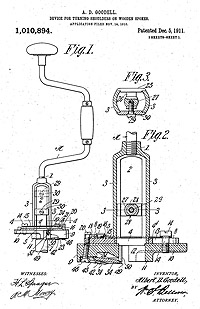 "Hollow Auger, No. 248
"Hollow Auger, No. 248
Patent Applied For
In designing this tool we
have aimed to combine the best of the old features with many
valuable new ones. The Cutter is so secured that it cannot
slip in use.
Changing the cut of the chip to any thickness
without changing the Cutter is another decided improvement.
It will handle any size
tenon from ¼ inch to 1-1/4 inch in diameter, 4 inches in
length; graduated for both diameter and length of cut.
Furnished with 14 inch sweep, with steel-clad head."
The last tool patented by Albert D.
Goodell was in production and for sale in 1911.